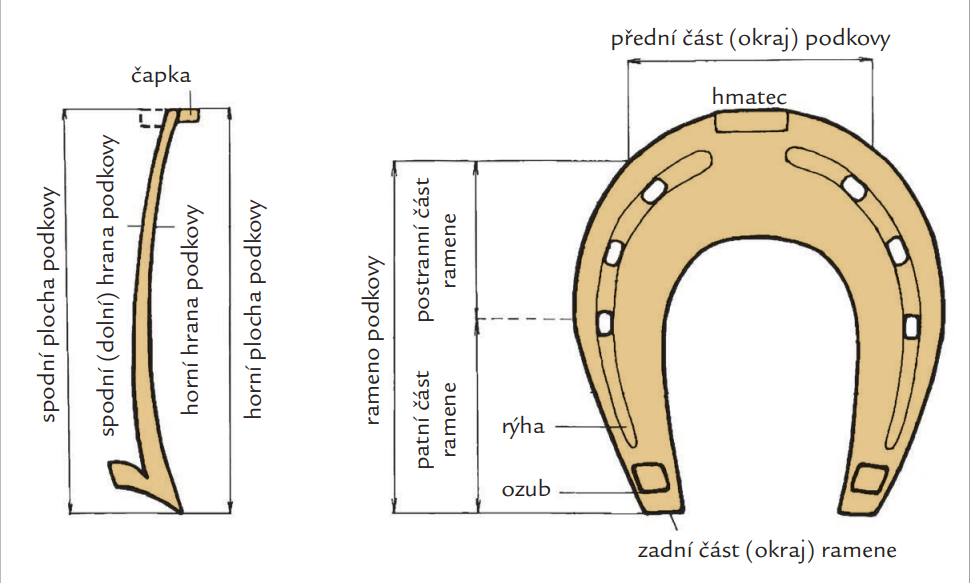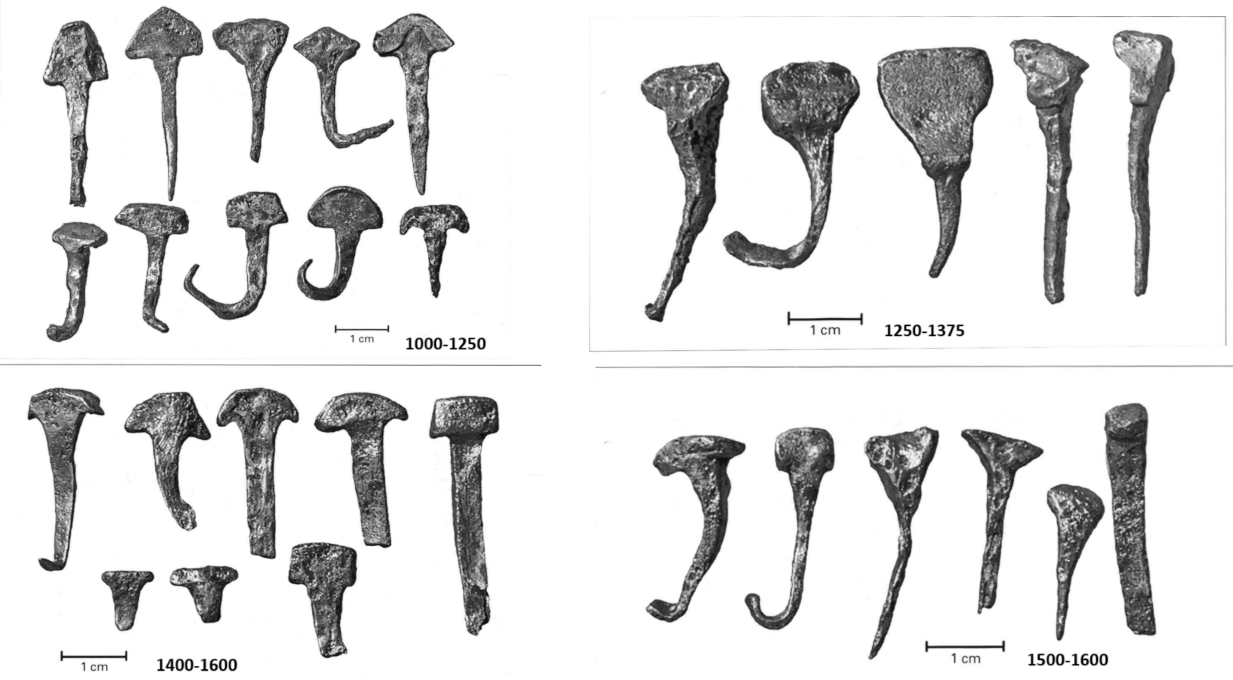Pane kolego, vskutku krásné čtivo, které všem zajisté pomůže 🔥. Avšak, článek o "kamenných mrtvolkách" gde?
Dating of horse shoes
Categories: Search instructions , Finds and rescue research in the Czech Republic
Horseshoe, probably the most common iron find during forest expeditions. Most prospectors dig it up by mistake and then hang it on a tree or leave it on a stump. Yet these are some of the oldest objects commonly encountered during a search, and can be useful clues to understanding the site.
 Horseshoe morphology
Horseshoe morphology
The oldest horseshoe found in our area comes from the Late Late Lateen period, from the South Bohemian oppida of Hrazany. However, they did not become common until the early Middle Ages, roughly from the 11th century onwards. These horseshoes were small, made of thin iron plate and did not have a grip or teeth; their role was fulfilled by large horseshoes. The change occurred around the second half of the 13th century.the 13th century, when, due to the increased workload of horses, we only see horseshoes withteeth, and within 100 years later, we also see the appearance of grippers, but their greatest spread dates back to the modern period. From the medieval context, we know them in our country, for example, from the extinct village of Konůvka, where they were dated before 1420.
When trying to date them, it is therefore a good idea to focus on the shape and size of the horseshoe itself, the formation of the teeth and the presence of a fretboard or its design. The studs used to attach the horseshoe to the hoof are also chronologically sensitive. In the 11th to 13th centuries they have a projecting trapezoidal head, but in parallel with them there are also more recessed T-shaped studs, which only become important from the 14th century onwards.
 The evolution of horseshoe pins
The evolution of horseshoe pins
Basic shapes
Horseshoes with a wavy edge are the oldest in our country, lacking a knob and the first ones also lack teeth. Here at Hunter they are sometimes identified as 'Celtic', but their date falls between the 11th and 13th centuries. A more detailed determination depends on the shape of the horseshoe holes, the number of teeth and the presence of reinforcement in the front of the horseshoe.
 Early horseshoe shapes with a fluted rim
Early horseshoe shapes with a fluted rim
Wedge-shaped tooth (sometimes also Spanish slipper), a relatively common and unmistakable horseshoe shape, appearing from the late 13th and early 14th century until the mid-15th century. Still lacking a fretboard, it is particularly notable for the variability of its teeth, which can vary in length and strength depending on the type of activity performed.
.png) Different shapes of wedge-shaped tooth (except Nos. 7 and 18)
Different shapes of wedge-shaped tooth (except Nos. 7 and 18)
Themost commonly found medieval horseshoes have simple teeth, formed by simply bending the ends of the arms. A knob may or may not be present. Their precise identification is difficult, so they are usually only tentatively dated to the High Middle Ages, the course of the 13th to 15th centuries.
 Commonly found shapes of Upper Medieval horseshoes
Commonly found shapes of Upper Medieval horseshoes
Horseshoes from the late medieval and early modern periods are characterised by broad shoulders that taper towards the teeth; the knob may or may not appear. They are usually dated to the turn of the Middle Ages and the modern period, between the 14th and 17th centuries.
 Horseshoes from the turn of the Middle Ages
Horseshoes from the turn of the Middle Ages
Modern horseshoes are easy to identify. They tend to be larger, almost always have a knob and usually have simple teeth; at the turn of the 19th and 20th centuries we also find threaded teeth.
 Horseshoes from the 18th and 19th centuries
Horseshoes from the 18th and 19th centuries
This summary should be considered the work of an amateur who has gained his knowledge by identifying his own finds through domestic and foreign articles. I do not guarantee the correct interpretation of the data, so please feel free to point out any errors. It will help not only me, but also other people who are not sure about their finds.
Useful materials to download:
- https://www.academia.edu/31085427/Podkovy_z_tzv_star%C3%A9_sb%C3%ADrky_Muzea_v%C3%BDchodn%C3%ADch_%C4%8Cech_v_Hradci_Kr%C3%A1lov%C3%A9_Pozn%C3%A1mky_k_typologii_st%C5%99edov%C4%9Bk%C3%BDch_a_novov%C4%9Bk%C3%BDch_n%C3%A1lez%C5%AF_Horseshoes_from_so_called_Old_collection_of_the_Museum_of_East_Bohemia_Hradec_Kr%C3%A1lov%C3%A9_Comments_on_typology_of_medieval_and_modern_finds
- https://limeslimits.files.wordpress.com/2016/07/fruchart_amsterdam_270616.pdf?fbclid=IwAR1DpjGSdNk4NaIIJ3pFzxRu7Wlwe5MmcU4l91dFzHtIcvQJtdAltbDf9Lw
- https://www.erlebnisausstellung.ch/wp-content/uploads/2020/07/Eine_Typologie_von_Hufn%C3%A4geln_als_Mittel_f%C3%BCr_Datierungen_2007_Brunner.pdf
- https://is.muni.cz/th/402261/ff_b/Bc_final_402261_9k8pa.pdf
- https://theses.cz/id/kk99gr/p_loha.pdf
- https://theses.cz/id/kk99gr/STAG85490.pdf
- https://www.erlebnisausstellung.ch/wp-content/uploads/2020/07/Die_Geschichte_des_Hufbeschlag_2010_Imhof_.pdf?fbclid=IwAR3MD5H7dn_2K8QFdSwNrqg5IGEI4NkGKkAan_1gwfWPT5cCxy72eKSNa6c
- https://books.google.it/books?id=0ctWAAAAcAAJ&printsec=frontcover&hl=it&source=gbs_ge_summary_r#v=onepage&q&f=false, pp. 162-165 contemporary illustrations of horseshoes, 1556
The article is included in categories:
- Archive of articles > Tutorials and History Hunters Magazine > Search instructions
- Archive of articles > Archaeology > Finds and rescue research in the Czech Republic
Post
Setkal si se při dohledávání informací s koňskými podkovami ve tvaru polovičního písmene U, tedy tvar stejný jako u volských podkov?
Pěkně napsané 👍
Setkal, ale přiznám se, že jsem je moc nestudoval. Volské podkovy opravdu nemusejí být vždy dvoudílné (podkování pro každý pazneht zvlášť), ale vzácně se vyskytují i vyrobené z jednoho kusu kovu, jako je tomu u koní. Zřejmě se ale nejednalo o vhodné ortopedické řešení, protože oba paznehty se u krav pohybují nezávisle na sobě, a jejich "uzamčení" jednodílnou podkovou se nemuselo kloubům líbit.
Já nikde informaci o těchto koňských podkovách nenašel, vždy je popisován pouze klasický „U“ tvar.
Jinak je dobré zmínit, že ne všechny podkovy byly vždy přikovány hřeby. Od středověku je znám typ tzv. koňské boty, tedy podkova byla ke kopytu resp. noze přivázána.
Tak oprava, již staří Římané přivazovali podkovu koním k noze koženým páskem.
Dobrý, přínosný článek, díkes pane 
Super. 

Paráda, podkovy mám rád. 
Velká paráda, děkuji 
pro Namora: odkaz č.7, strana 5 (pan Imhof)
pro Brumlu: znáš ,,Kovárna v Sezimově Ústí a analýza výrobků ze železa‘‘ Rudolf Krajíc (díl 3/I a 3/II)? doporučuji
https://1url.cz/vuUms
Pěkná práce!👍
Slušný👏👏👍
👍🏻👍🏻👍🏻
Díky za přehledný popis 👍🙂
Krásný článek! 👍👍👍
Hezký článek 👍
Parádne za 1000percent























